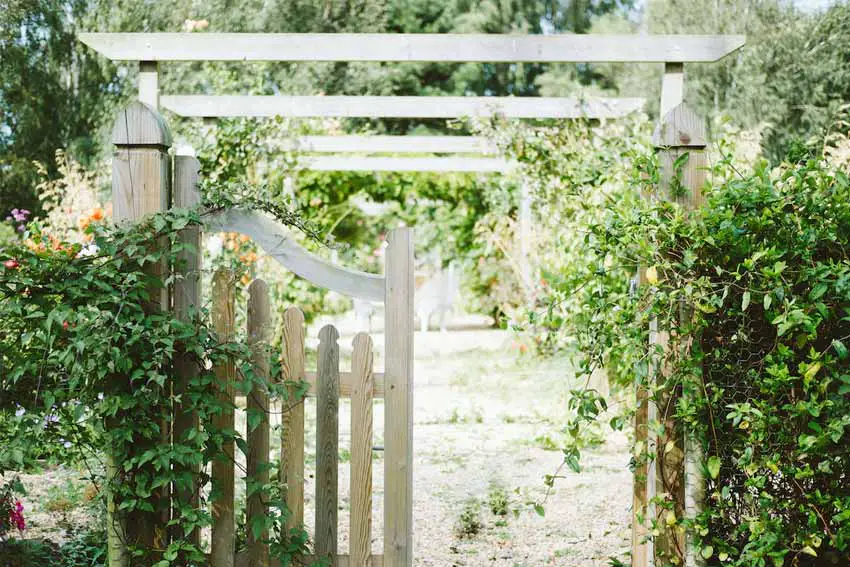Weed is a common problem in any garden, right? It hinders the natural growth of plants and vegetables. So, gardeners apply different tricks to get rid of weeds or at least reduce growing new weeds. Before that, it’s important to know about the effective weed barrier for gardens.
Nowadays different kinds of weed barriers are used but not all work in the same way. So, you may look for the best garden weed barrier and how to use it. Well, here we’ll guide you about that in-depth.
What is a Weed Barrier?

A weed barrier is a geotextile cloth consisting of polypropylene (or polyester in certain cases) with a meshed texture like burlap. It’s used mainly in gardens as weed protection. Weed barriers for gardens gained popularity in the mid-1980s whereas metal barriers in recent times..
Weed barriers keep consistent moisture under the weed barrier fabric. Sometimes mulch is used to cover the polyester or polypropylene geotextiles weed barrier for aesthetics as well as prevent deterioration from harsh weather like sun rays and rain.
Types of Weed Barriers for Garden
Weed barriers for gardens might be several types like the dog barriers for garden. Some of them are discussed below-
Natural Barriers
For centuries, different natural materials (like wood, metal) have been used as garden weed barriers. Some are thick layers of leaves, peat moss, mulch, straw, etc. These natural weed barriers are biodegradable but they might contain weed seeds sometimes that could worsen the situation. You can use them as temporary weed controlling, not as permanent solutions.
Homemade Barriers
Homemade garden barriers include newspapers, sheets of cardboard, plastic garbage bags, and so on. These weed barriers (except plastic) allow water, oxygen, and nutrients to reach the plant’s roots. They might be blown away by winds and look messy. However, you can economically make homemade weed barriers by recycling paper products.
Fabrics
This weed barrier is a very popular and effective way of weed control in the garden. It’s made from geotextile materials with a polyethylene or polyester thin lamination layer (usually black color). As said earlier, weed barrier fabric for vegetable gardens allows water, air, and nutrients to enter the soil. They last for several years and are quite expensive but provide great protection against weeds.
Plastics
The plastic weed barrier is one of the most effective weed barriers for gardens. It lasts longer and provides better weed protection than a fabric barrier (like the one between fence and soil). Plastic weed barriers have better UV protection which makes them pricier compared to cloth weed barriers.
It hinders sunlight, water, and oxygen to reach into plants’ roots thus weeds can’t grow beneath it. This would be the right choice for gardens, flower beds, stands of trees, or shrub borders for long-term use.

Benefits of Using Weed Barriers
Weed barriers provide lots of benefits to your garden such as-
- Weeds growth will be significantly reduced and even these might be eliminated fully.
- In terms of cost, weed barriers are pocket-friendly than other available landscape edgings.
- Weed barriers don’t use chemicals so they don’t harm the beneficial herbs or insects.
- They last longer and need less maintenance compared to other options.
- If you use weed barriers, they also protect the soil from erosion due to heavy rain.
- Cloth barriers are porous and help to reach water and nutrients in the plant’s roots. But if you want to block these elements use plastic weed barriers.
- When the ground is covered with weed barriers, water under the barriers won’t be evaporated. In this way, you needn’t water the plants frequently.
Is There Any Disadvantage of Using Weed Barrier in Garden?
Yes, there are some disadvantages of using garden weed barriers including-
- Some plants like Aubretia, Campanula, Geraniums, or Ajugas don’t grow well.
- Moving or transplanting requires extra effort.
- Watering on slopes is quite impossible.
- Hard to feed plants sometimes.
- Planting over the fabric seems awkward.
- Needs extra cover like mulch, stone, pebble, etc.
How to Use Weed Barrier in Vegetable Garden?

You can use a fabric weed barrier in the vegetable garden following the steps below-
Step 1: Clear and Level the Area
First of all, clear the spot where you want to place the weed barrier. You may dig out the existing weeds, vegetation, or grass for better results. Also, level the uneven ground to make it plane throughout the garden.
Step 2: Lay the Fabric Weed Barrier
Usually, manufacturers recommend laying the fabric and then cutting the slits where plants will dig in. Alternatively, you could plant the trees or scrubs first and then do the necessary cutting in the cloth and lay the weed barrier over the top of the plants.
Step 3: Secure the Fabric with Staples
Now, anchor the weed barrier for the garden bed so it won’t blow away during the wind. You can do it easily with a hammer and staples. Drive each staple 10 feet away.
Step 4: Add Mulch Layer
After laying down the weed barrier properly, now lay a 1 to 3-inch mulch layer over the weed barrier. The mulch layer will help to retain moisture and provides good aesthetics.
So, the garden weed barrier is ready.
How to Choose the Best Weed Barrier for Vegetable Garden?

Before you purchase good weed barriers for your garden, consider several important things such as-
Breathable Materials
The material selection is very important. If the weed barrier is made of breathable material, water and air can penetrate easily. So, you can get cloth weed barriers so plants get proper nutrients from the environment. But sometimes you might need plastic weed barriers to hinder proper weed growth.
Size of the Roll
How much space do you want to cover with weed barriers? Consider it and choose the roll according to this. You should purchase the required dimension weed barrier according to your need. Usually, the best garden weed barrier rolls are available in 300 to 750 feet in length and 4 to 10 feet in width.
Durable and Attractive
The weed barrier you are going to install in the garden should be durable enough so you can use it for several years without much maintenance. If it’s not durable, it’ll damage soon due to your walking, rain, snow, or wind. When talking about weed barrier color it should be invisible under mulch. Black and brown will blend mulch better.
Easy to Install
It’s also recommended to choose the weed barrier that is easy to install and requires less effort in repair and replacement.
Best Weed Barrier for Garden Suggestion
Here are several best weed barriers for vegetable garden suggestions.
Final Words
Who doesn’t prefer a weed-free garden? But it needs the effort to make the garden weed-proof. So, choosing the right weed barrier for the garden is important. Natural barriers or homemade barriers like leaves, paper, and cardboard aren’t so effective thus you should choose fabric or plastic weed barrier.
But considering water, air, and nutrients permissibility cloth weed barrier will be the best choice for the garden. Although, you have to invest quite high when installing fabric garden weed barriers, still, you’ll be a winner in the long run.

I’m Shofi, a passionate gardener and blogger. I have 10+ years of experience in gardening and hold certifications in horticulture and garden design. I share my knowledge and skills through my garden blog to inspire and educate others on the joys of gardening. I try to provide valuable information and create a community for gardeners of all levels to connect and learn. My ultimate goal is to inspire others to start their own gardens and connect with nature.

